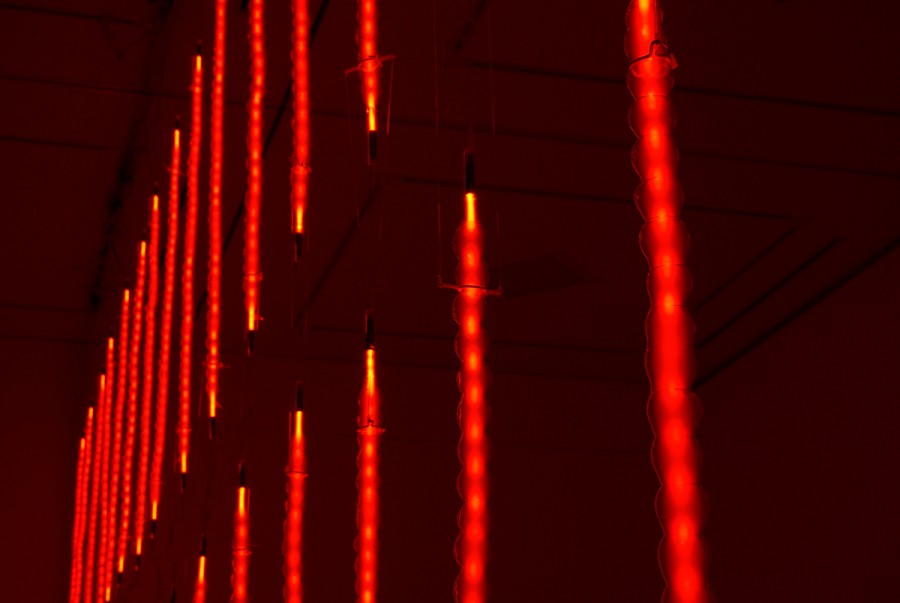
Installation view of Osaka Contemporary Art Center.

Installation view of Osaka Contemporary Art Center.

Installation view of Osaka Contemporary Art Center.

Installation view of Osaka Contemporary Art Center.

Installation view of Osaka Contemporary Art Center.

Installation view of Osaka Contemporary Art Center.
Recent Works of Takashi Kunitani
Shinichiro Osaki (Art Critic)
The exhibition of Takashi Kunitani's recent works has a paradoxical title of "The vertical Horizon.
" For those who are familiar with Kunitani works, it is not too difficult to understand the meaning of the vertical.
The first work that I have encountered was an installation where thirty red glass tubes filled with neon gas were
hung vertically from the ceiling, dividing a room diagonally.
The emphasis on the color red and the vertical lines dividing the space regularly, reminded me easily of
Barnett Newman's zip paintings.
Newman left the following words, which may have the decisive and important meaning in understanding
Kunitani's works: "One thing that I am involved in about painting is that the painting should give man a
sense of place: that he knows he's there, so he's aware of himself."
A sense of place that Newman refers, in my words, is the self-awareness about a site that the viewer
occupies. Kunitani's interest in site can be observed from the above-mentioned exhibition title.
The glass tubes hanging vertically are quite simple structures where the material itself is bared,
and in many cases, it is easy for us to grasp the whole as they are arranged regularly.
However, like the impression of the bell towers in Martinville that Marcel Proust had written, he glass tubes
change their appearances from moment to moment according to the site where the viewer occupies.
The complexity of experiencing simple forms. The relationship between the work and the viewer in an actual
space. It is needless to say that these were the themes of Minimal Art. Kunitani introduces another element
into his works. Let us recall that Proust's impression was written as a view from a traveling horse-drawn
carriage. In many cases, Kunitani's glass tubes are installed so that they invite the viewer to the inner part,
or lead him in a certain direction. The work should not be viewed from just one fixed point but should be
viewed on the premise that the viewer moves, thus the change of site. Such quality links his works to the
issue of time.
Similar to space, site is marked in time as well. Then the meaning of another, different type of work in this
exhibition, a bottomless hourglass, becomes clear. The grains of sand, falling form the glass tube with the
laws of gravity, accumulate conically on the floor.
While the time the sand in an ordinary hourglass ticks is repeated endlessly by turning the hourglass over
and over, the time the bottomless hourglass ticks is transient and unrepeatable, suggesting time in reality.
Then, the sand accumulated on the floor, or a lighted mosquito coil, an alcohol lamp burning in a glass case,
used in his previous works, can be regarded as the marks indicating the site of the viewer in the streams of
endless time.
For us the site is a place the body occupies for a time but usually we are unaware because it is too obvious.
However, on further reflection, the body, space and time , are irreplaceable and the site is given to a situation
when these three meet miraculously.
An experience to be with a piece of sculpture is primarily related deeply to the viewer's site, body and sense.
The surface of Kunitani's luminous glass tubes, vertically standing cylinders with delicately impressed unevenness,
made me think of Newman as well as Giacometti's sculpture.
Giacometti is an artist who was interested more in the space and distance where a model has been placed than
just the model herself in front of the artist. It is interesting to note that beyond the forms of painting of sculpture,
the works of Kunitani, Newman and Gacometti, all emphasize the verticality.
Kunitani's works have the formalistic completeness but they also make us strongly aware that our lives and
carried out at a specific site, on limited time and place, that is, "we know we're here."An experience of encountering
a work is an irreplaceable incident, happening at this place and at this time. Such premise, which seems so ordinary,
is apt to be overlooked today when the virtual predominates reality, overflowing with reproduction and repetition.
Kunitani's works do not take us away to the other shore, that is beauty, but they discipline the viewer in reality.
However, superb works, sculpture in particular, have been so always.
Spaceless Spaces
, 2007.Breath, Glass, Neon, Transformer, Cord
Dimensions variable (Neon Tube124 x φ3.5 cm each).





